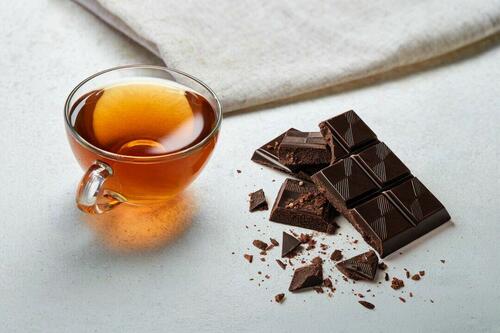Authored by George Citroner via The Epoch Times (emphasis ours),
We’re often advised to move more—whether through exercise or simply standing up—to counteract the adverse effects of prolonged sitting. But what if you could get the benefits of standing up simply by eating and drinking certain foods?

New research from the University of Birmingham, recently published in The Journal of Physiology, suggests that eating foods high in flavanols—such as tea, berries, apples, and cocoa—may help protect blood vessels from the damage caused by prolonged periods of sitting.
Sitting Increases Cardiovascular Risk
If you’re a young adult, chances are you’re sitting for about six hours a day—whether at a desk, in a car, or on the couch. All that sitting takes a toll on your blood vessels, raising your risk of heart disease, according to researchers.
Previous research has shown that even a 1 percent dip in how well your arteries expand and contract bumps up your risk of heart disease, stroke, and heart attacks by 13 percent.
The researchers set out to discover whether eating flavanol-rich foods could help offset such damage. Flavanols are naturally occurring compounds found in fruits, tea, nuts, and cocoa beans.
Lead author Catarina Rendeiro, assistant professor in nutritional sciences at the University of Birmingham, and her team recruited 40 healthy young men—half of them physically fit, and half not. Before having the participants sit for two hours, the researchers gave them drinks: some were given a high-flavanol cocoa beverage containing 695 milligrams of flavanols, while others received a low-flavanol version with just 5.6 milligrams.
The team then tracked what happened to the participants’ blood vessels during the two hours of sitting, measuring everything from artery flexibility to blood pressure, blood flow, and how well oxygen reached their leg muscles.
High Flavanol Drink Prevented Damage
After sitting for two hours, men who drank the low-flavanol cocoa experienced stiffening of their arteries, increased blood pressure, and decreased blood flow and muscle oxygenation, regardless of their level of physical fitness.
Conversely, those who drank the high-flavanol drink did not exhibit the same declines, suggesting that flavanols can prevent blood vessel damage associated with prolonged sitting.
“Our experiment indicates that higher fitness levels do not prevent the temporary impairment of vascular function induced by sitting when only drinking low-flavanol cocoa,” study co-author Sam Lucas, a professor of cerebrovascular and exercise physiology at the University of Birmingham, said in a statement. He noted that after drinking the high-flavanol drink, “both fitter and less-fit participants kept their FMD [flow-mediated dilatation] the same as it was before sitting for two hours.”
The study is the first to find that fitness levels do not influence how flavanols affect blood vessels, meaning everyone may benefit from flavanol intake regardless of physical fitness.
Rendeiro told The Epoch Times that the main mechanism by which flavanols work in the blood vessels is by boosting the availability of nitric oxide—a molecule that helps blood vessels relax and expand.
More specifically, she said, evidence from human and cellular models suggests that the flavanol epicatechin and its breakdown products can increase the bioavailability of nitric oxide.
The study did not include women, Rendeiro said, because hormonal changes during the menstrual cycle may influence flavanol effects.
“At the moment, we are not able to know whether these benefits would be apparent in women as well,” she said. ”This needs to be the focus of a future study.”
Estrogen, which rises during ovulation and falls when menstruation begins, has a vasodilatory effect on the vessels, which is generally associated with better blood vessel health, “so it is possible [the] benefits of flavanols may be more apparent during certain stages of the menstrual cycle versus others.”
Many Sources of Flavonols Available
“It is actually quite easy to add high flavanol foods to your diet,” doctoral student Alessio Daniele noted in the statement. He pointed out that there are cocoa products available in supermarkets and health stores that are processed through methods that preserve flavanol levels.
“If cocoa isn’t your thing,” (ZH: wtf) he said, “fruits like apples, plums and berries, nuts, and black and green tea are all common kitchen staples and are readily available.”
Rendeiro said that her research shows consuming high-flavanol foods and drinks during periods spent sitting down is a good way to reduce some of the impact of inactivity on the vascular system, but that breaking up sitting with standing or short walks should be our “main strategy.”
“However, in situations in which that is not possible, using healthy dietary strategies rich in flavanols may help mitigate some of the negative effects of sitting on vascular function.”
* * * Oh you thought this was an ad? Nope. Enjoy your chocolate and tea sirs and ma'ams.
Loading recommendations...